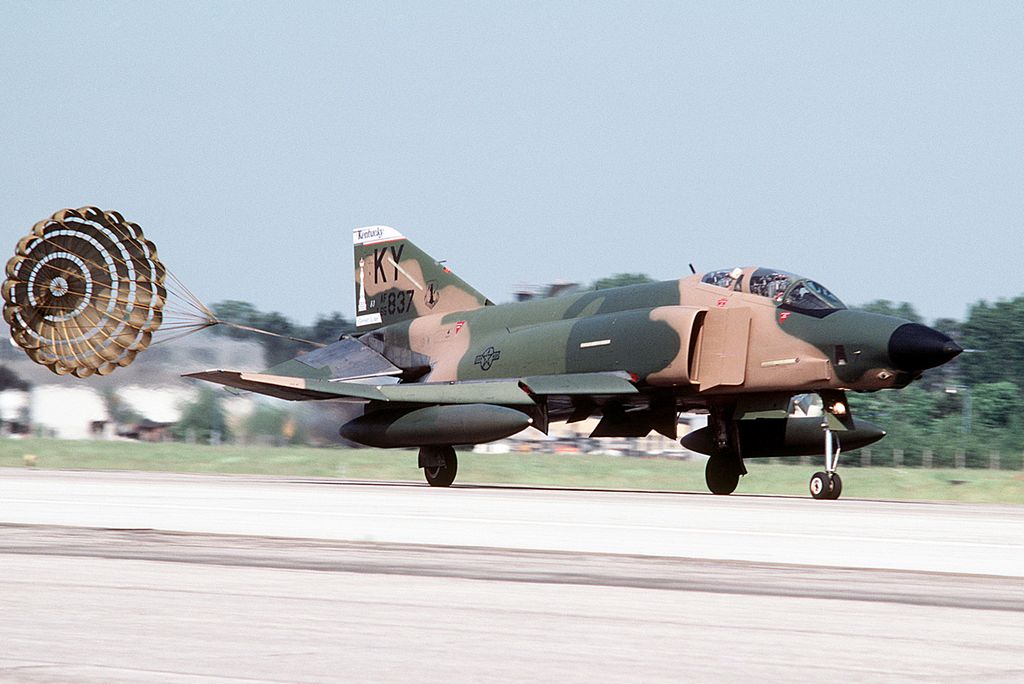A conventional F-4 ejection sequence calls for the back-seater to exit first, followed by the front seater, but Lieutenant Bell’s emergency canopy release line had been damaged by an internal fire, preventing it from blowing. Captain Sams was ejected from the aircraft in the meantime, but the backseat passenger remained inside
The following article titled Phantom Ejection and written by Charles Arrington & Robert Conely appeared in Volume II, No. 1 issue of Smoke Trails, Quarterly Journal of the F-4 Phantom II Society.
The ultimate test of man and machine is not necessarily conflict, just like with every piece of military equipment. Nothing could be more accurate in describing the circumstances that followed an in-flight incident and crew evacuation for Major Mike Sams, Captain Mike Bell, and RF-4C 64-1073.
The 165TRS/123TRW Kentucky Air National Guard members Mike Sams, a pilot, and Mike Bell, a back-seater, were both scheduled to have a typical day on Saturday, May 15, 1982. The two Mikes were supposed to take off on this particular day in an RF-4C from their base in Louisville to Savannah, Georgia. Their aircraft for the trip, a Recce Phantom 64-1073, was freshly painted and had just returned from depot maintenance. Sgt. John Hourigan, the crew chief, made a jest about avoiding scratching the paint on his recently repaired aircraft as they were ready to take off. This may have been a sign of things to come.

Major Mike Sams discussed being in the air that fatal day for about 45 minutes while flying above the Cherokee National Forest, which is located about 40 miles southwest of Knoxville, Tennessee, during an interview for this story. What happened was as follows. The Phantom’s left side experienced a loud explosion that activated the fire warning light. Sams set the throttle on the left engine to idle before shutting it off. Then, a right-side explosion triggered a fire warning light for that engine, prompting the pilot to move this engine’s throttle to idle in response.
He then pulled the aircraft in a zoom climb, raising it from 500 feet to 1500 feet while rolling it at a 45-degree angle. “Hey Jack, I think I’ve got a problem,” was all that Pilot Sams managed to say on the radio. As if this weren’t horrible enough, worse things kept happening. All electrical systems, including the radio, failed, allowing heat and smoke into the cockpit. The flight control systems then suffered a more significant breakdown. The KY ANG crew quickly decided to eject after losing control of their aircraft. Mike Sams estimates that the time from the initial issue and the start of the ejection process was only about 10-15 seconds.
Yet, this was not going to be a typical ejection. According to the Major, a standard F-4 ejection procedure calls for the back-seater to exit first, followed by the front-seater. Mike and Mike were unaware that Bell’s emergency canopy release line had been damaged by an internal fire, preventing it from blowing. Sams was released from the aircraft but the backseat passenger remained inside due to the Phantom ejection sequence mechanism. Bell tried using different seat ejection mechanisms when 64-1073’s altitude began to decline but to no avail. Once he engaged a typical canopy release, which raises the canopy for a typical ground egress, the canopy finally blew at 600 feet. Another successful ejection from the damaged RF-4C followed the removal of the second canopy in the ejection procedure.
When he descended under his parachute after ejecting at a greater altitude, Mike Sams had a good view of Bell’s chute opening and the blazing Phantom passing by in the shape of a “skyrocket.” In close proximity to a group of loggers who raced to help Bell, he practically landed unharmed. After it crashed against a ridge line covered with trees, the burning plane burst into flames. Knowing that he would eventually crash into a tree, Major Sams directed his parachute to the nearest tree branch before impact. Eventually, once he was safe on the ground, he realized he had compression fractures in his vertebrae and a separated shoulder. Before being rescued by an Army UH-1 helicopter sent from Knoxville, both soldiers lay on the ground for almost two hours.
Major Mike Sams thought back on the incident more than three years after his abrupt departure from RF-4C 64-1073. He claimed that in order to heal from injuries sustained during the ejection, he had to take three months off from flying. Sams, who has logged more than 2000 hours in the F-4, attributes his survival on that unforgettable day to the superb ejection seat training he received from Kentucky AG Life Support specialists as well as the competent base staff who maintained the ejection seat and life support equipment. Major Sams stated that material failure on the aircraft was likely the reason for the tragic Phantom 64-1073’s loss.

In the skies above rugged terrain, Mike Sams and Mike Bell faced the ultimate test of man and machine and triumphed, thanks in large part to their abilities, the instructors who prepared them for the job, and the experts who ensured their equipment worked when necessary.
Photo by TSgt. G. Dennis Plummer / U.S. Air Force

